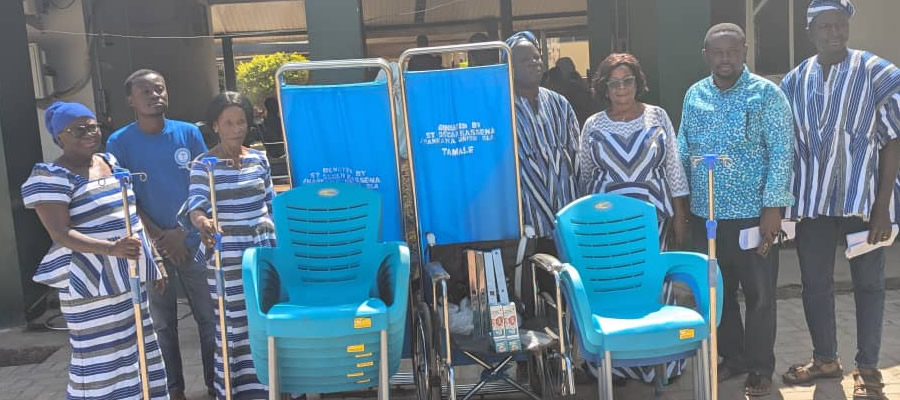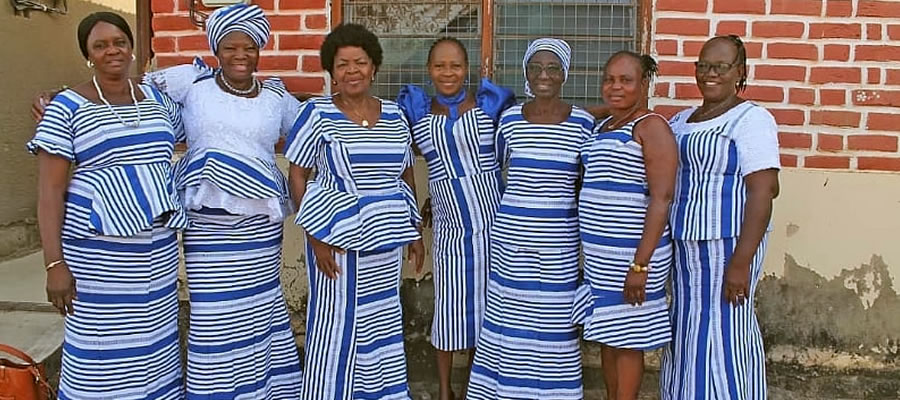

Population Characteristics
The population of the Municipality is projected to be 156,090 for 2010 for the Kassena Nankana and West Districts. Efforts are still being made to segregate the population figures for the two Assemblies. The gender grouping of the population is 75,548 people being male representing 48.4% and a female population of 80,542 representing 51.6%. The District has a population growth rate of 1 percent which is below the national growth rate of 1.1 percent. (2000 PHC)
Sex Composition
The sex composition of the Assembly’s population favours female. The female forms a little over one-half of the total population of the Municipality. The female population is estimated to be 77,575 representing 51.9 per cent while the male recorded 71,916 representing 48.1 per cent of the population. This is indicated in table 1.2.1.2 below.
Population Density
The Municipality recorded a population density of 91 persons per sq. km. This is higher than the national density of 79.7 persons per sq km but below the regional density of 104.1 persons per sq. km.
Fertility
The fertility rate is averagely 4.5
Growth
The population growth rate between 1960 and 1970 and also between 1970 and 1984 was 2.95 per cent and 3.0 per cent respectively but fell to 1 per cent between 1984 and 2000. This shows inter-censual decline of as much as 2.9 per cent (see Table 1.2.1.5 for population trend in the District).
Spatial Structure
The Settlement Structure
The Kassena Nankana is predominantly rural in out-look, comprising 216 communities. Aside Navrongo, Paga and few other settlements that records population of over 5,000 residents, most of the entire Municipality’s population live in rural settlements.
The settlement patterns are mostly dispersed as regards the local housing structure. Such structures are thus interspersed with households’ farmlands. Most of the urban settlements are located along the major road networks especially the Trans-National-ECOWAS route as well as nearer the capital – Navrongo.
The Built Environment
Over the few years past, some small towns have grown into urban and semi-urban status.It has a growth centre, being Navrongo Township (i.e capital), where most socio-economic activities meant to serve the entire District’s population are located. There are few growth points – Sirigu, Chiana and Paga. Some service centres including Kandiga, Manyoro, Naaga, Kologo, Nakong and vast rural settlements form the majority.
With the exception of Navrongo Township and lately Paga (the border town), most other settlements within the Municipaity have no properly drawn layout schemes for their physical development. As such, siting of physical structures in accordance with official standards is haphazard. Also, location of kiosks, stores and housing facilities even within Navrongo, Paga and other service centres including their immediate environs either for commercial and/or domestic purposes are arbitrarily placed due to the less enforcement of regulatory codes as well as ignorance.
Age Dependency
Dependency Ratio (DR) is defined as the ratio of the sum of the population aged below 15 years and above 65 years to the population between 14 and 65 years as expressed as a percentage.
The recorded age dependency ratio of 87.8 as indicated in Table 1.2.1.7. This means that 100 economically active persons have responsibility for approximately 88 dependents.
1.2.1.8 Geographical Distribution
The population density of 92 people per square kilometre shows how dispersed the population is. The Municipality consists of 216 communities – majority of which are rural, only 13 per cent of the population live in towns. At least three out of four people living in the Municipality reside in the rural areas. Table 1.2.1.8 depicts clearly the population sizes of the 10 largest settlements as follows:
Mortality
There has been an improvement in the mortality rate especially, infant and maternal mortally rates. Infant mortality has persistently been reducing from 2003 to 2005 as indicated in table 1.2.1.9 below. This success is as a result of improvement in access to basic health services, parental care, nutrition status and good sanitation.
Migration
Out migration is seasonal and more pronounced in the dry season. The youth (10-34 years) are the majority that migrates to the southern parts of the country in search of greener pastures. Most of them after the dry season return home to commence farming activities whiles others continue to hustle with great ambitions. This explains why the District recorded a tremendously low population growth rate of 0.1 in the year 2000 Population and Housing Census.
The trend of in-migration is very insignificant as mostly nomads from Burkina Faso and Mali, transferred workers and traders, especially during the tomato season travel into the Municiaplity.
Occupational Distribution
The mainstay of the local economy is agriculture, which accounts for about 68.7 per cent of the employable population. Public servants, traders, food processors and small-scale artisans constitute the remaining 31.3 per cent. It has virtually no sizeable manufacturing industries
The major occupations are Agriculture, employing about 68.7 per cent of the total labour force; production / transport operators and labourers constitute 10:4 per cent, Sales workers (9.2%), service workers (5.6%), Administration / Managerial workers (0.1%), professional technical workers (3.5%) and others (1.0%).
Agriculture and related workers (68.7%) are the single largest occupation; followed by production and transport equipment workers (10.4%), Sales workers are otherwise the third major occupation (Table 1.2.2).
Household Size
The average household size is seven (7). The extended family system accounts for the large household size, which is relatively higher than the national average of five (5) persons. Such large household sizes have socio-economic implications.
Land Title and Ownership
Individuals do not own lands but the family heads. The chiefs oversee the distribution and sale of land. The Tidanas/Tigatu are the original owners of the land; however they transfer land to other family heads.
Environmental Situation
Dry lands
The Kassena-Nankana lies within the dry land zone. The natural environment is fairly degraded as it faces severe threat of severe drought with high temperatures and perennial outbreak of bush fires. It is evident that high population densities (especially in towns) with high demand for land for constructional activities, extensive cultivation, over-grazing, erratic rainfall and the extent of devastation do affect the natural environment thereby exposing it to desertification.
It is therefore important for a conscious effort to be made to intensify education on environment implications with regard to sustainable developments. This is because economic development should progress hand in hand with environmental protection in the achievement of sustainable development.
Forest Resource and Production
Situation of Forest Resources
The Municipality has a forest reserve covering a total of 47,218 hectares. Off-reserve community fallow lands also contribute as forest resources. To recharge aquafresh systems and protect water resources, most forest reserves were established near rivers and other drainages. Table 1.3.1.1.1 below depicts the extent and ownership of forest in the Municipality.
Situation of Wood Production
The livelihood of majority of the residents is directly bound to the forest resources, as most settlements are rural. They depend on rafters and poles from the forest for the construction of their houses. Fuel wood constitutes the major traditional energy source. Almost the entire population depends on either firewood and charcoal or both for domestic and commercial use.
The major economic tree species include Mahogany, Dalbergia, Teak (exotic), Daniela (potential but has not been fully harnessed), Eucalyptus, Albizea, Kapok and Acacia.
Forest Plantation
The total area of plantation comprising all the nine forest reserves is estimated to be 47,218 hectares. The following species are generally planted – Teak (exotic), Nim, Mahogany, Eucalyptus, Dalbergia. All the reserves belong to the state. The rural forestry programme in the 1980s enabled individuals and groups to establish off-reserves community woodlots.
Forest Industries
With the exception of some exploitable economic species as Mahogany, there are no large timber trees. There are therefore no timber rights given within the reserves.
Non-Timber Forest Products
Baobab, Dawadawa and shea fruits are mainly gathered and processed for domestic consumption and sale to earn additional income. The communities rely on the forest for their medicinal needs.
Farm Forestry and Extension
Despite efforts to provide seedlings to schools and communities, there has not been enough commitment by the residents to go into forestry. However, the rural forestry programme in 1980, NGO’s and CBO’s assisted communities (individuals) and schools to establish their own plantations for woodlot and as wind break.
The Forestry Commission in collaboration with the communities has embarked on Agro-forestry on virtually degradable lands owned and controlled by the two parties. This new policy direction is based on the “Taungya” system in which farmers cultivate food crops alongside the trees. Farmers will enjoy 40% of the proceeds when the trees are finally sold.
Issues on Fire
Outbreak of bush fires is rampant especially during the long dry season, all of which being human caused disasters. Fire belts of 5-metres width are created to protect forest plantations against fire. There are no green belts established yet.
Development Partners in Forestry
Due to severe encroachment and degradation that disturb the forest resource, thus a constant threat of extinction, various non-governmental organizations and CBO’s have joined hands to embark on agro forestry programmes.Notably among them are the Gia/Nabio Agro-forestry Development Organizsation (GNADO) and ADRA.
Under the Community Collaborative Forestry Initiative (CCFI), Nurseries have been established at Paga and Kandiga.
Date Created : 11/20/2017 7:56:34 AM











 facebook
facebook
 twitter
twitter
 Youtube
Youtube
 +233 593 831 280
+233 593 831 280 0800 430 430
0800 430 430 GPS: GE-231-4383
GPS: GE-231-4383 info@ghanadistricts.com
info@ghanadistricts.com Box GP1044, Accra, Ghana
Box GP1044, Accra, Ghana